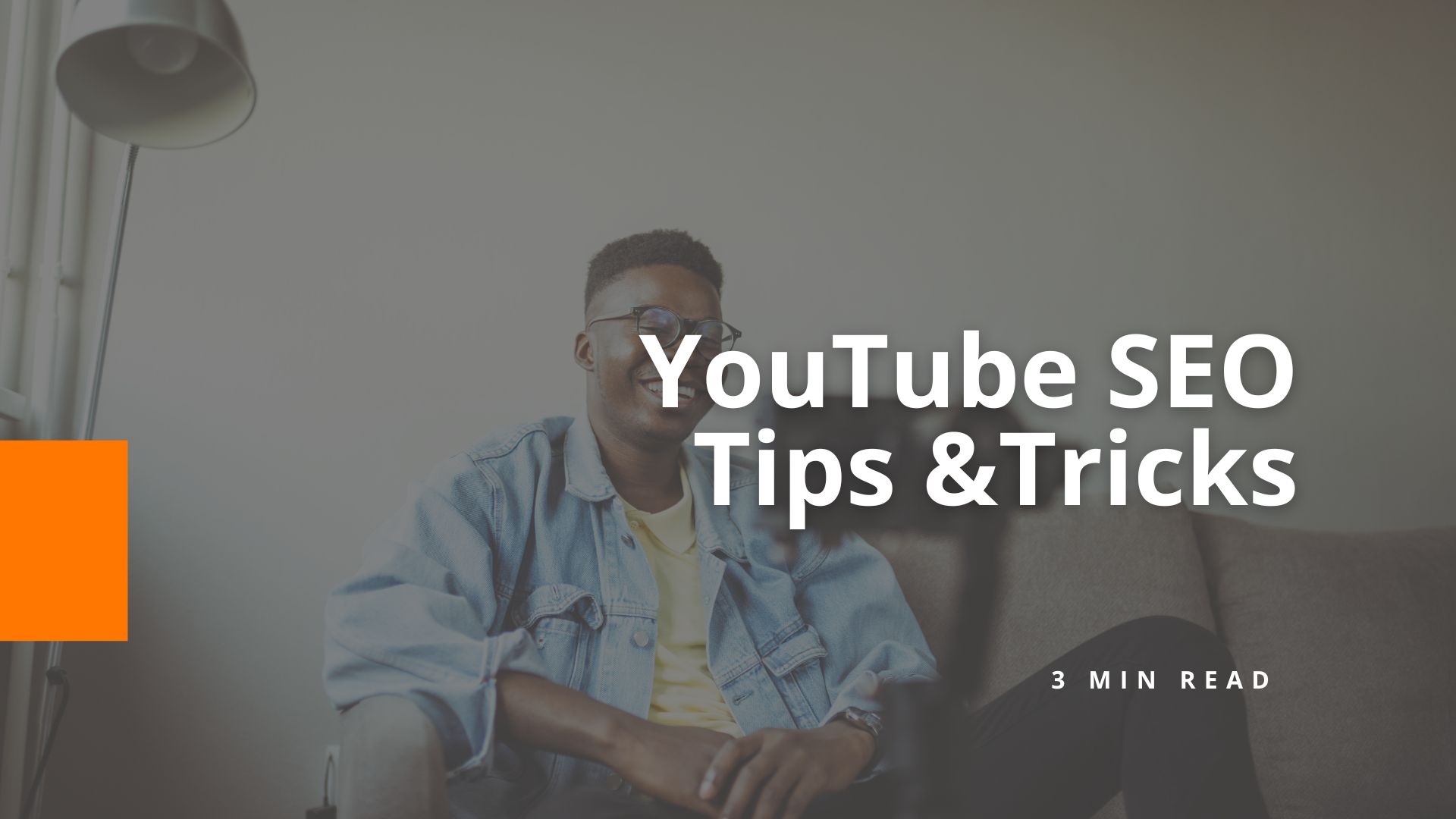YouTube SEO: How to Optimize Videos for YouTube Search

Your website isn’t the only thing that needs to be SEO optimized; your social media does, too. YouTube has its own set of optimization techniques in order to improve your rankings, visibility and engagement. When you understand the search algorithm and apply the SEO techniques, you’ll maximize your video’s reach and find a new audience. Keep reading for a walkthrough on the best practices to optimize your videos for YouTube search.
Understanding YouTube’s Algorithm
The goal of YouTube’s algorithm is to deliver the most relevant video to the user based on their search and viewing habits. YouTube evaluates every video based on:
- Watch time: The longer someone watches your video, the more value YouTube thinks it has.
- Engagement metrics: YouTube ranks videos with more engagements (likes, comments, shares and subscriptions) rather than one with a lower engagement rate.
- Metadata optimization: The crawlers can’t actually watch your video so they use things like your video title, description, tags, caption and other metadata to determine its relevance.
- Search history and personalization: YouTube will take into account what the viewer has watched in the past. By optimizing your video to rank higher, the viewer will be more likely to watch your video and then get more of your videos recommended to them.
When you create engaging videos that are optimized for these factors, you’ll increase the likelihood your videos rank higher in search results and recommended sections.
Why Optimizing Videos for YouTube Search is Worth It
There are so many reasons to invest in a good YouTube SEO strategy. One of the biggest reasons? Our SEO bestie, Google, owns YouTube, which means that if your video ranks well on YouTube, it can rank well in a Google search.
Here are some more benefits to optimizing your videos for YouTube search:
- Higher rankings = more visibility: Just like our SEO BFF, Google, when you optimize your YouTube videos, it will improve your discoverability.
- More engagement = better performance: When you optimize your videos, you’ll get more engagement, more followers and increase your rankings.
- Long-term benefits: YouTube videos are what those in the biz call evergreen content, meaning their relevance and value tend to last a little bit longer. If done correctly, your videos can generate traffic for years.
A majority of this work is done by actively offering solutions for viewers’ problems or providing other valuable content. After that, it’s just a matter of refining your strategy.
Step-by-Step Guide to Optimizing Videos for YouTube Search
1. Keyword Research for YouTube SEO
Your first step should always be keyword research. You should do this ideally when you’re coming up with ideas and again when you’re creating the description.
YouTube itself is where you can search for keywords. Use the search bar, type in a keyword and you’ll see other relevant search terms pop up. Use those.
These are the best practices for your keyword search:
- YouTube loves it when you use the auto-suggestions
- Use a mix of exact-match and broad-match keywords
- Incorporate your keywords naturally into the title, description and tags
2. Crafting an SEO-Optimized Video Title
YouTube’s search crawlers don’t watch your video. They rely on things like your title to understand what the video is about to rank it properly. Make sure your title is engaging, descriptive and most importantly, uses your main keyword.
Use these best practices:
- Keep your title clear and concise, with 60 characters or less.
- Don’t be “clickbait-y” but try to write a strong title that encourages people to click.
- Place the exact keyword near the beginning of the title.
3. Writing an Effective Video Description
Your description is a great place to help you rank on YouTube. It helps the crawlers and viewers understand what will be discussed in the video to determine relevance. In your description, use the keyword naturally throughout, provide a summary of the video’s content, add a clear call-to-action (CTA) and include timestamps for easier navigation.
4. Using Tags, Categories and Hashtags
Tags might not carry the weight that they used to, but along with categories, they will help YouTube classify your content. Use a mix of broad and specific tags, including your main keyword. If this blog was a video, we might use tags like “YouTube SEO,” “YouTube Tips” and “Social Media.”
When you are selecting a category for your video, use the one that closely matches your video.
You can also use hashtags to help with optimizing videos for YouTube search. Like with tags, use relevant hashtags in the description. Unless you are a brand that everyone knows, you don’t hashtag your company name. If they’re searching for your company, you’ll pop up with your user name.
5. Creating an Engaging Video for Higher Watch Time
YouTube’s strongest ranking factor is how long people are watching your videos. By creating engaging videos, your users will keep watching and not click away.
Here’s how you can increase your watch time:
- Hook your viewers early, ideally in the first 5 seconds of your video. People won’t sit through a video if you spend the first 15 seconds on irrelevant information.
- Structure your content in a way that’s interesting. This can mean storytelling or a quickly paced video.
- Prioritize making your video high-quality, with clear audio and easy-to-understand language.
- Give a compelling reason to watch more of your video at the beginning. Don’t use clickbait to do this; your viewers will be annoyed.
6. Enhancing Video SEO With Thumbnails, Subtitles and Captions
While a thumbnail doesn’t directly influence your video’s rank, a well-designed thumbnail does increase your click-through rates. Ensure it’s high-contrast and readable, even on mobile.
By adding subtitles and captions, you make your videos easier to watch for everyone. It also helps you rank higher because a crawler can see them if you upload an SRT file or use the auto-caption feature. If you are using captions, please edit them to be accurate!
7. Boosting Engagement With Cards, End Screens and Playlists
Clicks and additional watch time help YouTube recognize the value of your content. One way to do this is by using YouTube’s cards, end screens and playlist features.
- Cards: Allows you to link to related videos, polls or external sites.
- End screens: Like a card but at the end of the video, the end screen allows viewers to see another relevant video before they click away. This keeps them on your channel longer (which YouTube loves.)
- Playlists: Grouping related videos together encourages binge-watching and increases the watch time on your channel.
8. Leveraging YouTube Analytics for SEO Improvement
When optimizing your videos for YouTube search, you’ll want to see if your efforts are working. To do this, you need to dive deep into the analytics section of the YouTube Studio. When you monitor the numbers regularly, you can refine your strategy and improve your content.
You should look at one or all of these key metrics:
- Watch time: Shows if viewers are watching the video all the way through.
- Audience retention: This metric shows where people stop watching your video. If it’s in the first 10 seconds, is it because you didn’t create a good hook or because you started with irrelevant information?
- Click-through rate: Shows you if people are actually clicking on the video. This can indicate if your titles and thumbnail strategy is working.
- Traffic sources: Shows where your viewers are coming from.
There are tons of analytics for you to parse through, especially when you click on advanced mode. Use the metrics that make sense for your company’s goals.
9. Implementing Calls-to-Action (CTAs) for Engagement
A strong CTA encourages viewers to take action, whether it’s subscribing, liking, commenting or watching another video.
You have to tell your viewers what to do sometimes; people may not naturally click the like button or subscribe. So, let them know that’s what you want! It’s called a call to action (CTA) and it can be anything from asking them to subscribe, like your video, comment on it or check a link in the caption. You should both verbally ask viewers in the video and have it in your caption.
Get Found! Optimize Your Videos for YouTube Search
When you optimize your videos for YouTube search, you’ll grow your audience and increase the visibility of your videos. Focus on keyword research, metadata and engagement strategies to further maximize your ranking and reach. The more optimized your content is, the better your chances of success on YouTube.
Since we just talked about CTAs, here’s the one for this blog: Book a meeting with us to grow your YouTube or other social media accounts.




